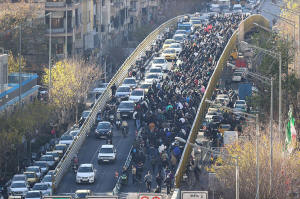At least 35 people have been killed and 1,200 detained in Iran's
economic protests
[January 06, 2026] By
JON GAMBRELL
DUBAI, United Arab Emirates (AP) — The death toll in violence
surrounding protests in Iran has risen to at least 35 people, activists
said Tuesday, as the country's theocracy acknowledged the unrest in one
western province where security forces reportedly raided a hospital.
The figure came from the U.S.-based Human Rights Activists News Agency,
which said more than 1,200 people have been detained in the protests,
which have been ongoing for more than a week.
It said 29 protesters, four children and two members of Iran’s security
forces have been killed. Demonstrations have reached over 250 locations
in 27 of Iran’s 31 provinces,
The group, which relies on an activist network inside of Iran for its
reporting, has been accurate in past unrest.
The semiofficial Fars news agency, believed close to Iran’s paramilitary
Revolutionary Guard, reported late Monday that some 250 police officers
and 45 members of the Guard’s all-volunteer Basij force have been hurt
in the demonstrations. However, Iran's government has offered no overall
statistics or information about the unrest.
Iran promises Ilam investigation
Late Monday, Iranian President Masoud Pezeshkian assigned the country's
interior ministry to form a special team for a “full-fledged
investigation” of what had been happening in Ilam province. Malekshahi
County in Iran’s Ilam province, some 515 kilometers (320 miles)
southwest of Iran's capital, Tehran, has seen protesters killed as
online videos purported to show security forces firing on civilians.

The presidency also acknowledged an “incident in a hospital in the city
of Ilam.” Online video showed security forces wearing riot gear raiding
a hospital, where activists said they were seeking demonstrators.
The hospital assault drew criticism from the U.S. State Department,
which in Iran's Farsi language called the incident “a crime.”
“Storming the wards, beating medical staff and attacking the wounded
with tear gas and ammunition is an clear crime against humanity,” a post
on the social platform X read. “Hospitals are not battlefields.”
A report by Fars earlier alleged without offering evidence that
demonstrators carried firearms and grenades. Firearms are more prevalent
in western Iran, along the border with Iraq, but there’s been no clear
evidence provided by the government to support allegations of
demonstrators being armed. Ilam has hundreds of kilometers (miles) of
border with Iraq.
[to top of second column] |

Protesters march on a bridge in Tehran, Iran, on Dec. 29, 2025.
(Fars News Agency via AP, File)
 Iran's rural Ilam province is mainly
home to the country's Kurdish and Lur ethnic groups and faces severe
economic hardship.
Protester deaths a focus of Trump
The growing death toll carries with it the chance of American
intervention. U.S. President Donald Trump warned Iran on Friday that
if Tehran “violently kills peaceful protesters,” the United States
“will come to their rescue.”
While it remains unclear how and if Trump will intervene, his
comments sparked an immediate, angry response, with officials within
the theocracy threatening to target American troops in the Mideast.
The comments took on new importance after the U.S. military on
Saturday captured Venezuelan President Nicolás Maduro, a longtime
ally of Tehran.
The protests have become the biggest in Iran since 2022, when the
death of 22-year-old Mahsa Amini in police custody triggered
nationwide demonstrations. However, the protests have yet to be as
widespread and intense as those surrounding the death of Amini, who
was detained over not wearing her hijab, or headscarf, to the liking
of authorities.
Iran has faced rounds of nationwide protests in recent years. As
sanctions tightened and Iran struggled after a 12-day war with
Israel, its rial currency collapsed in December, reaching 1.4
million to $1. Protests began soon after, with demonstrators
chanting against Iran’s theocracy.
On Tuesday, $1 traded at 1.46 million rials.
Understanding the scale of this latest round of protests has been
difficult. Iranian state media has provided little information about
the demonstrations. Online videos offer only brief, shaky glimpses
of people in the streets or the sound of gunfire. Journalists in
Iran also face limits on reporting in general such as requiring
permission to travel around the country, as well as the threat of
harassment or arrest by authorities.
But the protests do not appear to be stopping, even after Supreme
Leader Ayatollah Ali Khamenei on Saturday said “rioters must be put
in their place.”
All contents © copyright 2026 Associated Press. All rights reserved
 |